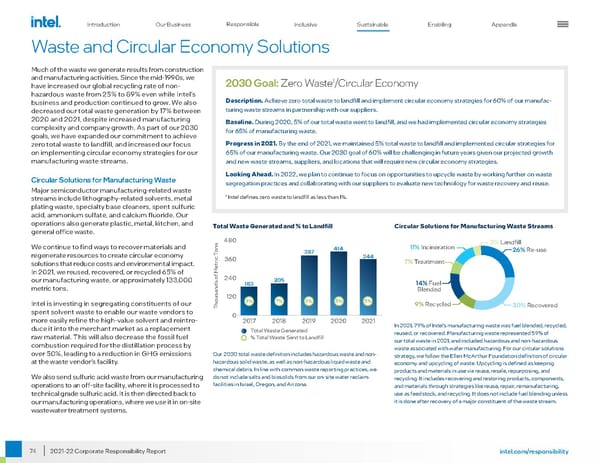74 intel.com/responsibility 2021-22 Corporate Responsibility Report Waste and Circular Economy Solutions Much of the waste we generate results from construction and manufacturing activities. Since the mid-1990s, we have increased our global recycling rate of non- hazardous waste from 25% to 89% even while Intel’s business and production continued to grow. We also decreased our total waste generation by 17% between 2020 and 2021, despite increased manufacturing complexity and company growth. As part of our 2030 goals, we have expanded our commitment to achieve zero total waste to landfill, and increased our focus on implementing circular economy strategies for our manufacturing waste streams. Circular Solutions for Manufacturing Waste Major semiconductor manufacturing-related waste streams include lithography-related solvents, metal plating waste, specialty base cleaners, spent sulfuric acid, ammonium sulfate, and calcium fluoride. Our operations also generate plastic, metal, kitchen, and general office waste. We continue to find ways to recover materials and regenerate resources to create circular economy solutions that reduce costs and environmental impact. In 2021, we reused, recovered, or recycled 65% of our manufacturing waste, or approximately 133,000 metric tons. Intel is investing in segregating constituents of our spent solvent waste to enable our waste vendors to more easily refine the high-value solvent and reintro - duce it into the merchant market as a replacement raw material. This will also decrease the fossil fuel combustion required for the distillation process by over 50%, leading to a reduction in GHG emissions at the waste vendor’s facility. We also send sulfuric acid waste from our manufacturing operations to an off-site facility, where it is processed to technical grade sulfuric acid. It is then directed back to our manufacturing operations, where we use it in on-site wastewater treatment systems. 2030 Goal: Zero Waste 1 /Circular Economy Description. Achieve zero total waste to landfill and implement circular economy strategies for 60% of our manufac - turing waste streams in partnership with our suppliers. Baseline. During 2020, 5% of our total waste went to landfill, and we had implemented circular economy strategies for 65% of manufacturing waste. Progress in 2021. By the end of 2021, we maintained 5% total waste to landfill and implemented circular strategies for 65% of our manufacturing waste. Our 2030 goal of 60% will be challenging in future years given our projected growth and new waste streams, suppliers, and locations that will require new circular economy strategies. Looking Ahead. In 2022, we plan to continue to focus on opportunities to upcycle waste by working further on waste segregation practices and collaborating with our suppliers to evaluate new technology for waste recovery and reuse. 1 Intel defines zero waste to landfill as less than 1%. Total Waste Generated and % to Landfill Our 2030 total waste definition includes hazardous waste and non- hazardous solid waste, as well as non-hazardous liquid waste and chemical debris. In line with common waste reporting practices, we do not include salts and biosolids from our on-site water reclaim facilities in Israel, Oregon, and Arizona. % Total Waste Sent to Landfill Total Waste Generated 240 0 Thousands of Metric Tons 360 120 2020 2021 2018 2019 2017 480 183 205 387 344 414 7% 3% 5% 9% 5% Circular Solutions for Manufacturing Waste Streams In 2021, 79% of Intel’s manufacturing waste was fuel blended, recycled, reused, or recovered. Manufacturing waste represented 59% of our total waste in 2021, and included hazardous and non-hazardous waste associated with wafer manufacturing. For our circular solutions strategy, we follow the Ellen McArthur Foundation definition of circular economy and upcycling of waste. Upcycling is defined as keeping products and materials in use via reuse, resale, repurposing, and recycling. It includes recovering and restoring products, components, and materials through strategies like reuse, repair, remanufacturing, use as feedstock, and recycling. It does not include fuel blending unless it is done after recovery of a major constituent of the waste stream. 26% Re-use 30% Recovered 9% Recycled 14% Fuel Blended 7% Treatment 11% Incineration 3% Landfill Introduction Our Business Responsible Inclusive Sustainable Enabling Appendix
 Intel Corporate Responsibility Report Page 73 Page 75
Intel Corporate Responsibility Report Page 73 Page 75